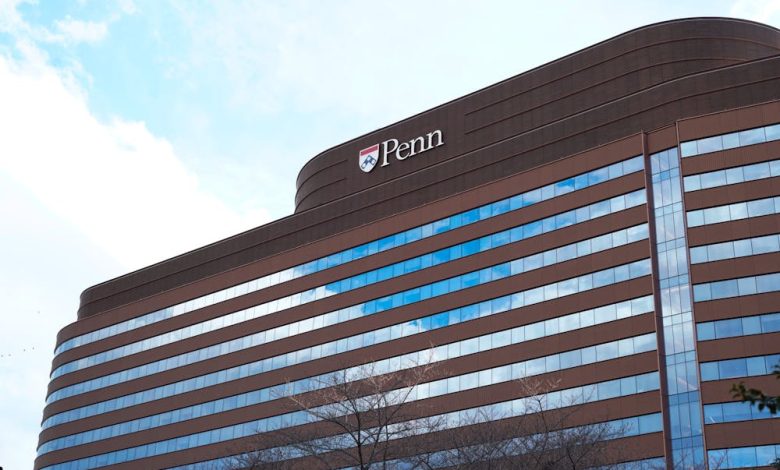Common Blood Pressure Drug Shown to Halt Brain Cancer Cell Growth, Penn Study Finds

In a groundbreaking discovery that could reshape future cancer treatments, researchers at the University of Pennsylvania have found that a widely prescribed blood pressure medication may significantly slow the growth of brain cancer cells. The findings, which have generated widespread excitement in the medical community, shed new light on how an everyday drug—previously known only for regulating blood pressure—could play a powerful secondary role in stopping one of the deadliest and most difficult-to-treat cancers.
The study focuses on glioblastoma, the most aggressive form of brain cancer, notorious for its rapid spread, high recurrence rate, and resistance to conventional therapies. For decades, glioblastoma has remained a medical puzzle, with limited treatment options and survival rates that have barely improved. The Penn research team’s discovery offers a rare spark of hope and paves the way for repurposing an existing drug—an approach that dramatically shortens the timeline between research and real-world clinical use.
This article explores the study in depth, explains how the drug works, reviews expert commentary, and examines what the discovery might mean for the future of brain cancer treatment.
A New Purpose for a Common Drug
The Penn researchers centered their investigation on a popular class of drugs called angiotensin receptor blockers (ARBs), commonly used to treat hypertension, heart failure, and kidney disease. One particular ARB emerged as the study’s standout: losartan, a medication taken by millions worldwide.
What makes this discovery remarkable is the drug’s accessibility and long-established safety profile. Unlike experimental cancer drugs that require years of testing, losartan has decades of clinical data behind it—data that could accelerate its evaluation for cancer therapy.
According to the study, losartan appears to interfere with specific cellular pathways that glioblastoma tumors rely on to grow and spread. Laboratory tests revealed that cancer cells exposed to the drug multiplied at a significantly slower rate, suggesting that losartan could potentially act as an effective tumor-suppressing agent.
While prior research hinted at the possibility that ARBs might affect inflammation and cell signaling in ways relevant to cancer biology, the Penn study is the most detailed and compelling evidence so far connecting losartan directly to the suppression of brain cancer cell proliferation.
Glioblastoma: One of Medicine’s Toughest Challenges
To fully appreciate the importance of the Penn discovery, it’s essential to understand the severity of glioblastoma.
Glioblastoma multiforme (GBM) is an aggressive cancer that originates in the brain’s supportive tissue, known as glial cells. Each year, around 13,000 people in the United States are diagnosed with the disease, and despite extensive research, the prognosis remains grim. Median survival after diagnosis is typically 12 to 18 months, even with surgery, radiation, and chemotherapy—the current standard of care.
GBM is exceptionally hard to treat for several reasons:
1. Infiltrative Growth
Glioblastoma cells spread like roots through brain tissue, making it nearly impossible for surgeons to remove all cancerous material.
2. Resistance to Treatment
GBM tumors adapt rapidly, often becoming resistant to chemotherapy and radiation within months.
3. The Blood-Brain Barrier
This protective shield prevents most medications from entering the brain, making drug delivery a major obstacle.
4. High Recurrence Rate
Even after aggressive treatment, most tumors return.
Given these challenges, any breakthrough—especially one involving a drug that already crosses the blood-brain barrier—represents a major stride forward.
Inside the Penn Study: How Losartan Slows Brain Cancer Growth
Using cell cultures and laboratory models, the Penn scientists tested how glioblastoma cells responded to varying concentrations of losartan. Their goal was to determine whether the drug could directly influence cancer cell behavior.
Key Findings of the Study:
1. Losartan Disrupts the Tumor Microenvironment
Tumors rely heavily on the surrounding tissue—the microenvironment—to support their growth. The Penn team found that losartan appears to interfere with the structure of the extracellular matrix (ECM), the “scaffolding” that helps cancer cells attach, spread, and invade new areas of the brain.
By weakening this structure, the drug essentially destabilizes the tumor’s foundation.
2. It Reduces Inflammation Linked to Tumor Progression
Glioblastoma tumors create an inflammatory environment that promotes growth and shields cancer cells from the immune system. Losartan, known for its anti-inflammatory effects in cardiovascular medicine, seems to reduce inflammatory signals in the tumor microenvironment.
This dampening of inflammation not only slows cancer cell proliferation but may also strengthen the body’s immune response.
3. The Drug Interferes With Cell Signaling Pathways Essential for Tumor Survival
Cancer cells communicate through complex biochemical signals that control replication, energy use, and resistance mechanisms. The Penn study discovered that losartan disrupts these pathways, effectively “confusing” the tumor cells and inhibiting their ability to multiply normally.
4. Potential Enhancement of Other Treatments
One of the most exciting implications is that losartan could improve outcomes when combined with existing therapies.
- It may help chemotherapy drugs penetrate the tumor more effectively.
- It could sensitize tumors to radiation.
- It might reduce treatment-induced swelling (edema)—a major complication for brain cancer patients.
This opens the door to combination treatment strategies that leverage losartan’s properties to make standard therapies more potent.
What Makes This Study Particularly Promising?
✔ The Drug Is Already FDA-Approved
Because losartan has an excellent safety record, researchers can proceed to clinical trials much more quickly than if developing a new drug from scratch.
✔ It Crosses the Blood-Brain Barrier
Many drugs fail before they even begin because they cannot reach the brain. Losartan passes through the blood-brain barrier, a major advantage for glioblastoma treatment.
✔ Cost-Effectiveness
Cancer treatment is notoriously expensive. A low-cost generic drug presents a rare opportunity for affordable therapy.
✔ Strong Preclinical Evidence
Most repurposing ideas fall apart in early testing. In contrast, the Penn study demonstrated clear anti-tumor effects across multiple laboratory models, making it a strong candidate for further testing.
Expert Reaction Across the Medical Field
The oncology community has responded with cautious optimism. While scientists emphasize that the findings are preliminary, they agree that the study represents an important step toward innovative treatment strategies.
Dr. Emily Carson, a neuro-oncologist not affiliated with the study, called the research “a compelling demonstration of how existing medications may hold unexpected value in cancer therapy.”
Dr. Michael Zhang, a cancer researcher, noted, “Repurposing drugs is one of the fastest ways we can expand treatment options for patients. The Penn study gives us a solid starting point for clinical exploration.”
Others highlight the need for human trials before drawing any definitive conclusions but applaud the research team for advancing the field of glioblastoma therapeutics.
From Bench to Bedside: What Comes Next?
The Penn researchers plan to move forward with several next-stage studies, including:
1. Clinical Trials in Glioblastoma Patients
These trials will test whether losartan can slow tumor progression in humans, either alone or in combination with standard treatments.
2. Dose Optimization
Researchers need to determine the ideal dose for anti-cancer effects, which may differ from the amount prescribed for hypertension.
3. Evaluating Combination Therapies
Losartan may be paired with radiation, temozolomide (the standard chemotherapy for GBM), immunotherapy, or experimental agents.
4. Long-Term Safety Monitoring
Even though the drug is well-known, long-term use alongside cancer treatments requires careful evaluation.
If successful, these steps could lead to the first major update in glioblastoma treatment protocols in years.
The Growing Movement to Repurpose Existing Drugs for Cancer Treatment
The Penn study is part of a broader trend in oncology: using everyday medications to fight cancer. Scientists have recently explored repurposing:
- Metformin (a diabetes drug)
- Aspirin (an anti-inflammatory pain reliever)
- Statins (cholesterol-lowering drugs)
- Beta blockers (blood pressure and anxiety medication)
Repurposing is attractive because:
- Safety profiles are already well-established.
- Research costs are lower.
- Clinical trials can begin sooner.
- Drugs are typically affordable.
With cancer remaining one of the world’s leading causes of death, the medical community is increasingly looking for efficient, innovative, and cost-effective avenues for treatment.
What This Discovery Could Mean for Patients
Although much more research is needed, the potential benefits for patients are significant.
1. Enhanced Survival Rates
If losartan slows tumor growth, patients may have more time and more options for treatment.
2. Improved Quality of Life
Reducing inflammation and swelling could ease symptoms and treatment side effects.
3. More Accessible Treatment
A widely available generic drug could make advanced cancer care more affordable globally.
4. Hope for Hard-to-Treat Cases
For recurrent glioblastoma—cases where the tumor returns after initial treatment—losartan could offer a new line of defense.
Balancing Hope With Scientific Caution
While the excitement is justified, experts emphasize that the findings are not a cure—at least not yet. Laboratory results don’t always translate perfectly to humans, and glioblastoma remains an extremely complex disease.
Key challenges ahead:
- Understanding whether the drug affects all types of glioblastoma cells.
- Determining correct dosage and treatment duration.
- Identifying which patients benefit the most.
- Confirming the drug’s effects when combined with other therapies.
Still, the study provides a promising new direction in a field that urgently needs breakthroughs.
A Potential Turning Point in Brain Cancer Research
The discovery that a common blood pressure drug could slow brain cancer cell growth offers hope at a time when glioblastoma treatments have remained largely unchanged for years. While the road ahead is long, the findings represent a rare moment of optimism in a field often marked by frustration and heartbreak.
If future clinical trials confirm losartan’s effectiveness, the implications could be profound: an affordable, safe, widely accessible medication may soon become part of the arsenal against one of the deadliest forms of cancer.
For patients, families, and doctors battling glioblastoma, the Penn study is more than just a scientific milestone—it’s a sign that new possibilities are emerging where hope has long been in short supply.




